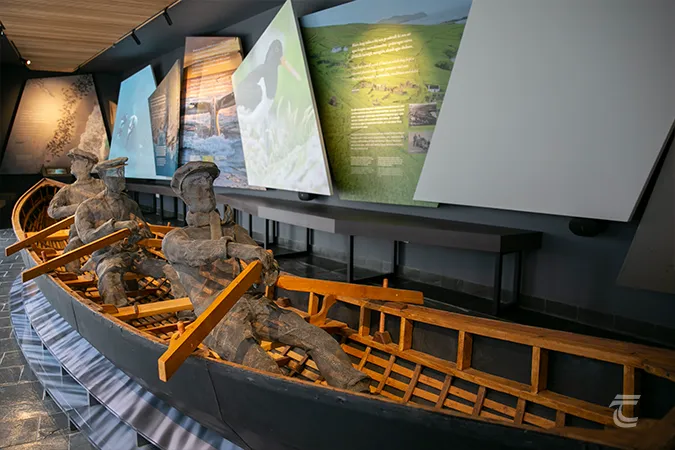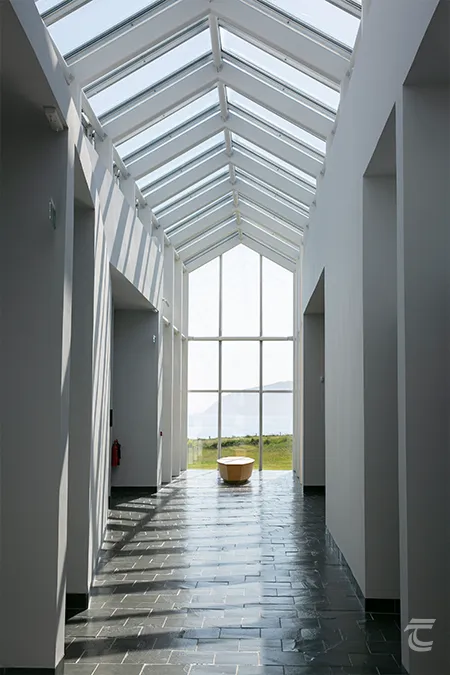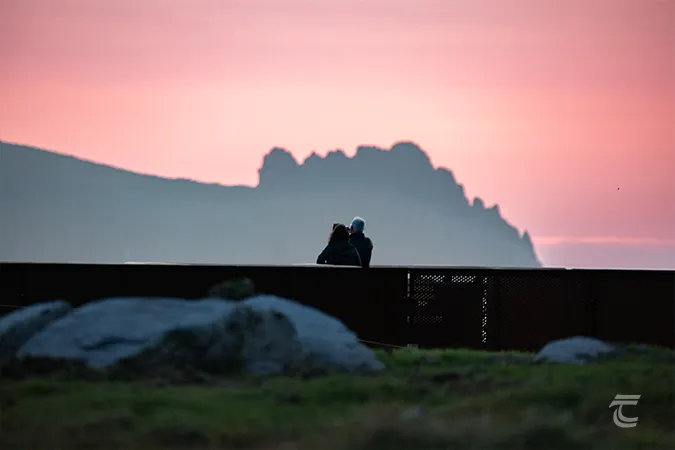Ionad an Bhlascaoid • The Blasket Centre
The excellent, bright and airy Blasket Centre, or in Irish, Ionad an Bhlascaoid, honours the community that called the Blasket Islands their home until the island was finally evacuated in 1953. The Blasket Centre houses an extensive collection of photographs, writings and storyboards, models, artworks, documentary films and research resources along with fine café. The exhibition also recreates the interior of a typical Blasket Island dwelling, where you can see the everyday features of the home, offering a small but intimate glimpse into their daily life.
The islands were a beautiful if harsh home, and the stunning scenery and life on the Great Blasket Island has inspired a plethora of poets, folklorists, ethnographers and artists over the years. The islands themselves have a rich literary tradition, with writers and storytellers such as Tomás Ó Criomhthain, Muiris Ó Súilleabháin and Peig Sayers. Peig is perhaps the most familiar of the Blasket writers, as she was a regular feature on the Irish school syllabus. Peig was a renowned storyteller, with a great store of knowledge about the folklore and traditions of the Blasket Islands and surroundings. She was born in Dunquin, and worked around Dingle as a servant, until she married Patsy Guiheen and moved to the Great Blasket Island in 1892. She was particularly renowned for her beautiful use of the Irish language.
For practical information about visiting this site Click Here
The excellent, bright and airy Blasket Centre, or in Irish, Ionad an Bhlascaoid, honours the community that called the Blasket Islands their home until the island was finally evacuated in 1953. The Blasket Centre houses an extensive collection of photographs, writings and storyboards, models, artworks, documentary films and research resources along with fine café. The exhibition also recreates the interior of a typical Blasket Island dwelling, where you can see the everyday features of the home, offering a small but intimate glimpse into their daily life.
The islands were a beautiful if harsh home, and the stunning scenery and life on the Great Blasket Island has inspired a plethora of poets, folklorists, ethnographers and artists over the years. The islands themselves have a rich literary tradition, with writers and storytellers such as Tomás Ó Criomhthain, Muiris Ó Súilleabháin and Peig Sayers. Peig is perhaps the most familiar of the Blasket writers, as she was a regular feature on the Irish school syllabus. Peig was a renowned storyteller, with a great store of knowledge about the folklore and traditions of the Blasket Islands and surroundings. She was born in Dunquin, and worked around Dingle as a servant, until she married Patsy Guiheen and moved to the Great Blasket Island in 1892. She was particularly renowned for her beautiful use of the Irish language.
For practical information about visiting this site Click Here
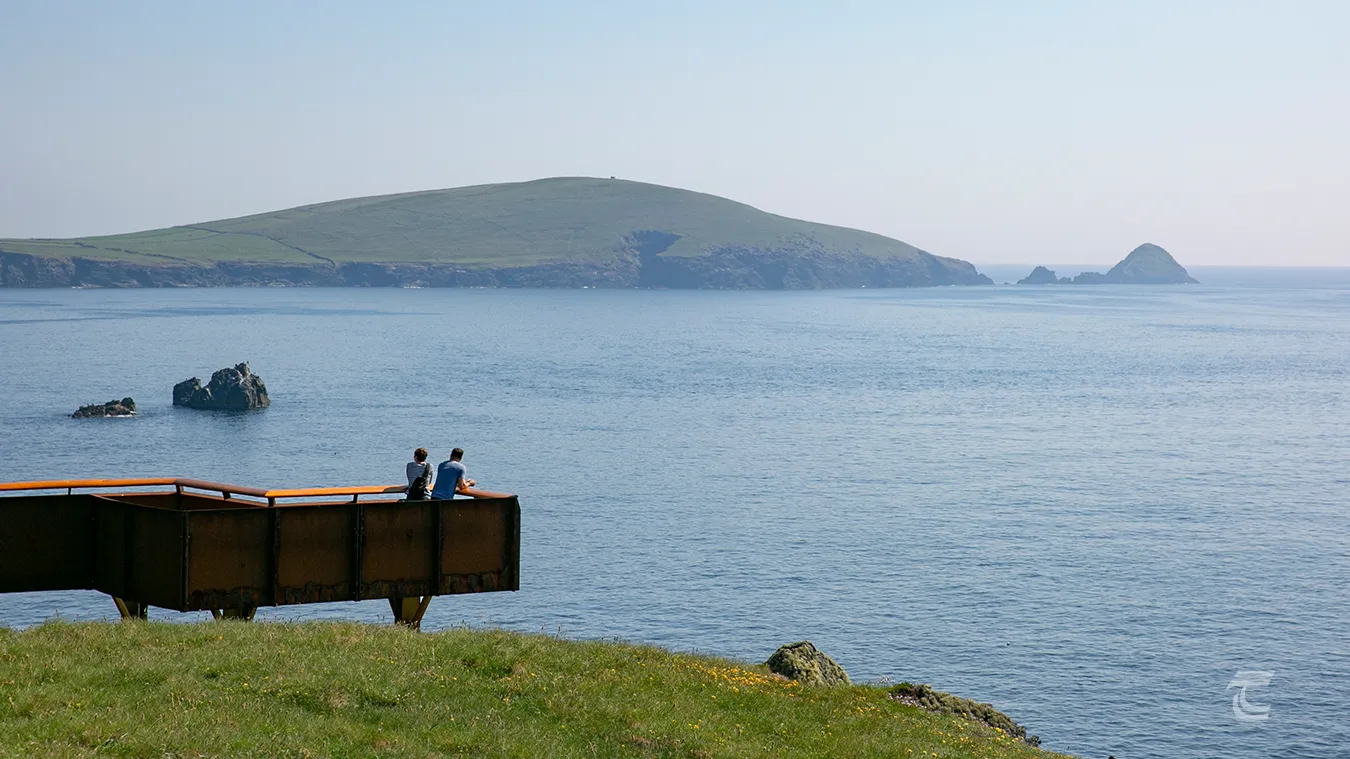
The viewing platform of the Blasket Centre • Dingle Peninsula • Kerry
The Viewing Platform at the Blasket Centre and the Blasket Sound
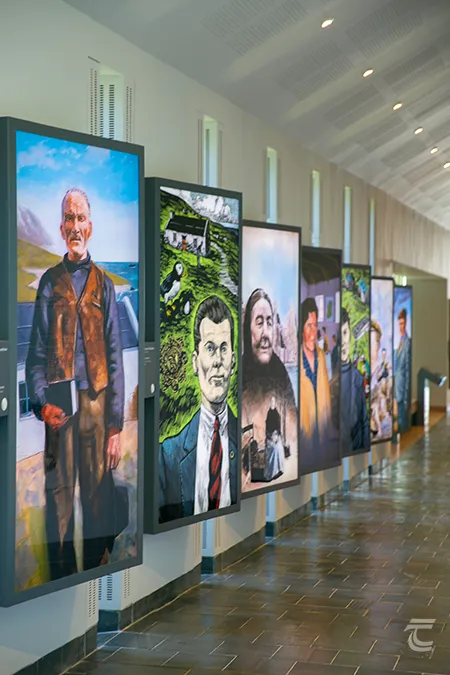
Portraits of the Blasket Writers • Ionad an Bhlascaoid, the Blasket Centre
‘Tá Pheig Mhór ar na cainteoiri is fearr dá bhfuil ar an oileán; tá an stil chainte aici chomh soiléir snasta sin gur féidir leat gach aon chor cainte a thuiscint gan stró; tá an óráidíocht ginte inti; tá tuiscint chomh géar sin aici ar chora cainte na Gaeilge agus ar rithim agus ar cheol na teanga go bhféadfaí gach focal dá ndeir si a scríobh sios ar theacht amach as a béal dóibh…’
‘Big Pheig – Peig Mór – is one of the finest speakers on the island: she has so clean and finished a style of speech that you can follow all the nicest articulations of the language without effort; she is a natural orator with so keen a sense of the turn of phrase and the lilting rhythm appropriate to the Irish language that her words could be written down as they leave her lips…’
You can take a trip to the Great Blasket Island from the picturesque harbour of Dunquin, but please be aware that the terrain of the island can be challenging and the weather changeable, so be sure to wear suitable clothing and good boots. You can read more about the story of the Great Blasket Island and the visitor experience in our article here.
As part of its recent upgrade, the Blasket Centre has a large viewing platform that offers a stunning view over the islands. You can also enjoy the view along with the famous Dunquin Pier (Dún Chaoin). Inis Tuaisceart is the island that most grabs the eye. It is known as the Sleeping Giant, or in Irish as ‘An Fear Marbh’ (‘the dead man’), as it has the distinct look of a man lying on his back.

Portraits of the Blasket Writers • Ionad an Bhlascaoid, the Blasket Centre
The stretch of waters between the mainland and the Blasket Islands is known as the Blasket Sound, and despite it appearing to be relatively narrow and tranquil on a fine day, it has often proved to be a dangerous passage for unwary or unlucky seafarers due to its unpredictable tides and unforgiving rocks. In 1588 five ships from the Spanish Armada sought shelter in the Blasket Sound. One of them, the Santa Maria de la Rosa, hit the rocks and immediately sank. Only the pilot’s son survived. Islanders regularly had to brave the Blasket Sound in lightweight coracle boats made of tarred canvas over a wooden frame, known locally as naomhóga. Looking over the waters towards the islands, the old tune ‘Port na bPúcaí ’ arrives unbidden, but very welcome, to the mind. This slow air is thought to have originated in the Blasket Islands, where some believe it was inspired by the song of the humpback whale, an occasional visitor to these waters.
Upper left: artistic representation of islanders pulling the oars of a naomhóg • Lower left: enjoying the sunset on the viewing platform • Right: the bright corridor of the Blasket Centre
Top: artistic representation of islanders pulling the oars of a naomhóg • Middle: the bright corridor of the Blasket Centre • Bottom: enjoying the sunset on the viewing platform


